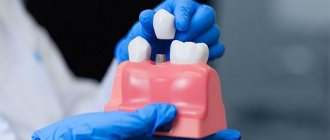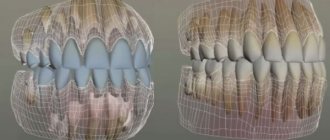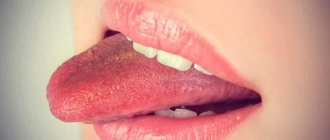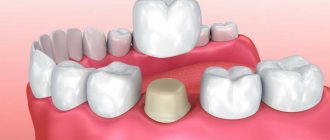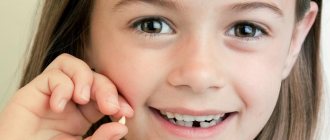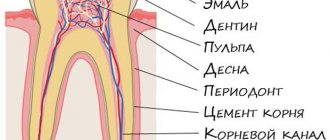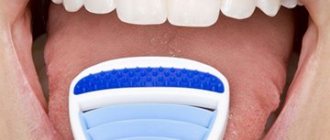Quite often, caring parents begin to worry about the fact that the baby’s front molars do not grow after the baby teeth have fallen out. It is necessary to understand that the growth of permanent teeth is a long and gradual process. Parents should pay attention to the fact that milk units are not replaced by radical units in the exact sequence. After a front baby tooth falls out, a small portion of the new, permanent tooth will emerge first.
Many children experience such phenomena when teeth do not grow in the generally accepted order. All babies are individual and have their own body characteristics. There is no need to worry prematurely. Parents should be aware that indigenous units take longer to grow. If immediately after the loss of a baby tooth the front tooth does not grow, this is not yet a pathology. In many babies, permanent units appear only a few months after the loss of milk. In this article we will look at the main reasons why a child’s molar front tooth does not grow.
Why do people not immediately grow permanent teeth?
Adults have 32 teeth, although some have only 28. A child's jaw is so small that so many teeth cannot fit in it. Therefore, the baby grows only 20 teeth, which then change. As the child grows older, the size of the jaw also increases. Permanent teeth begin to emerge at the age of 6 or 7 years. However, they form under the first row of teeth from the birth of the baby. This causes baby teeth to be replaced by molars and fall out.
Milk teeth are a kind of “pioneers”. They “show” the natives where they should go when growing. Over time, they inevitably begin to wobble and fall out. If a baby tooth falls out and a new one does not grow, parents need to take the child to the dentist.
Is it possible to grow a baby tooth on an adult?
If the baby tooth is mobile or does not suit you from an aesthetic point of view, you still need to start with an x-ray examination. If the x-ray reveals that there are no permanent tooth buds, and the roots of the baby tooth have resolved, while the baby tooth has mobility of 3–4 degrees (that is, the tooth is very mobile), then it should be removed and further decide what type Prosthetics are more suitable for you to replace the loss.
If you are not satisfied with the appearance of the tooth, it is necessary, again using an x-ray, to determine the condition of the rudiments of the permanent tooth and the roots of the baby tooth. Further decisions will depend on each specific case, including the age of the patient and the place in the dentition of the baby tooth. If there are no rudiments and the roots of the baby tooth have not resolved, then you can install a veneer on it or carry out a tooth restoration, which will make it invisible in the dentition. And for those who want to completely transform their hair, we can recommend getting lumineers.
If there are rudiments of a permanent tooth, in this case it is worth assessing how much time they need before erupting and making a decision about removing the baby tooth and “pulling out” the permanent one.
Although milk teeth in adults are an anomaly, this is not a reason to necessarily part with them - they can serve you well for many years to come. However, it is possible that this “greetings from childhood” prevents the permanent tooth from growing. So, if you suddenly have a baby tooth, be sure to take an x-ray and consult a specialist.
Timing of eruption of molars
Before you figure out why baby teeth fall out and new ones don’t grow, you need to find out the timing and norms for the growth of molars, established by dentists. This will allow you not to panic ahead of time and consult a doctor in time if necessary.
The rudiments of baby teeth begin to form in the first trimester of pregnancy (at 8 weeks), and at 20 weeks the rudiments of molar teeth are formed. They are located very deep in the baby's jaw. It should be understood that not all teeth that erupt in a little person will fall out in the future. Some of them become permanent immediately.
The baby's first tooth appears at approximately 6 months. By the age of three, all his teeth have grown. When do the molars erupt?
By about 7 years of age, the baby grows molars, which in dental practice are called sixth teeth. At the age of 11 to 13 years, molars also appear, but this time the 7th ones. These teeth do not have milk analogues; after eruption, they immediately become permanent. All other molars gradually replace baby teeth. At the age of 6 to 8 years, the child’s central incisors sprout, and from 7 to 9 years, the lateral incisors erupt. From 10 to 12 years of age, the child begins to grow premolars, which are also called fifth and fourth teeth, according to the dental formula. Molar canines erupt between the ages of 9 and 13 years. Adults develop wisdom teeth, but not always. Considering that the process of changing teeth takes place according to a certain schedule, parents are concerned about why their child is experiencing some kind of delay. Usually they are very worried about why the baby teeth have fallen out, but the permanent teeth are not growing.
Change process
The jaw of a child under 5 years of age is distinguished by a small jaw arch , which is not capable of accommodating the entire set of full-fledged molars. Therefore, it is first filled with temporary crowns, which are characterized by their small size and thin, shortened root.
They prepare the gums for secondary eruption and determine the location in the jaw arch for permanent teeth. During the process of replacement, the root of temporary teeth gradually dissolves and the crown part is only slightly retained by the gum tissue.
The permanent tooth, developing in place of the milk root, eventually pushes out the temporary crown .
Physiological causes of pathology
The primary dentition is not immediately replaced by primary teeth. After a baby tooth falls out, a certain period of time must pass. Only after this does the molar appear. Subsequently, he completely takes the place of his predecessor. But some children, even 3 weeks after the loss, do not even have a hint of teething. Parents are starting to worry. However, this does not always indicate the presence of the disease. There are cases when the dental body began to erupt only after 1 or 2 months. There could be many reasons for this. In addition, there are cases that even adults retain their baby teeth. Only a specialist can determine this.
One of the reasons why a baby tooth falls out and a new one does not grow is the absence of its rudiments. Pathology can be diagnosed using an x-ray. In this case, the patient is given dental plates, and upon reaching adulthood, a new dental body is implanted. There is no other way to solve the problem.
But there are teeth, the formation of which occurs quite late. These are eights. Their rudiments are formed only in adolescence - at 13 or 14 years old.
Parents should remember that they should go to the hospital in a timely manner in all cases if any pathology is noticed in the child’s oral cavity. If more than three months have passed since the tooth loss, and there is also redness and swelling of the gums, then you cannot do without the help of a doctor. Such symptoms indicate that the dental body cannot erupt. In this case, the edge of the gums may acquire a blackish tint. In this case, the specialist must open the gum so that the new tooth can emerge.
When considering the question of why the baby fang fell out and the molar (or other teeth) does not grow, it is necessary to establish the causes of the pathology. They are as follows:
- Infections that affected the formation of dentition rudiments.
- Serious mechanical injuries.
- Incorrect dental treatment.
- Lack of calcium in the body.
- Unbalanced child's diet.
- The presence of caries, which slows down the development of the permanent tooth.
In what sequence are they replaced with permanent ones?
The period of change of bite begins at 6 years of age and ends at 13–14 years of age. The interval can vary within a radius of 2 years. There is a certain order of drops:
- The first to fall out are the lower primary incisors, which were the first to erupt.
- Then - the upper front ones,
- Side lower front.
The situation can vary depending on factors when there is not enough space for neighboring teeth and they push others. Changing the sequence should be a signal to visit the dentist.
Very often there are complications during the period of mixed dentition, when the first one stands motionless in place, but is pushed out by the permanent tooth that grows from above. Parents should take the child to the dentist to resolve the situation. If the tooth itself does not fall out, it needs to be pulled out . So that the new one is even.
We need to help children brush their teeth, because they cannot yet perform precise movements. The arsenal should include:
- Brush,
- A thread,
- Tongue scraper.
The child needs to be instilled with dental culture so that he is not afraid to take care of his oral cavity. When a tooth falls out, the wound should not be smeared or rinsed, so that a plug does not fall out, which forms in its place and closes the path for the entry of microbes.
Their change, as a rule, occurs unnoticed, asymptomatically, painlessly. Sometimes the gums can become inflamed. In this case, you will need to consult a doctor, and it is necessary to treat the disease as problems arise. This will directly impact the oral health of long-term residents.
The shift time is constant for each person and is set individually. But if there is a significant slowdown, it is important to consult a doctor. He will promptly help solve the problem. During the period of occlusion change, the diet should contain hard foods.
It is necessary to load the jaw so that all physiological processes occur harmoniously. If parents see problems with uneven growth, it is important to get a consultation in a timely manner and consult with an orthodontist.
Other causes of deviations
Worried about why a baby tooth has fallen out and a new one is not growing, many parents think about physical pathologies. They do not realize that there are some other reasons that contribute to the disruption of the development of permanent dentition. Negative factors include:
- Poor environmental conditions.
- Eating foods that are harmful to the body.
- Frequent stressful situations.
- Eating cereals and purees too often.
How to avoid problems
To avoid problems associated with delayed growth of molars,
Expectant mothers must adhere to some rules:
- Avoid bad habits, since smoking and drinking alcohol can negatively affect the development of tooth buds.
- Carefully monitor your oral hygiene and visit your dentist promptly.
- Take care of your health, do not contact sick people during pregnancy.
- Try to strengthen your immune system in every possible way.
- Avoid eating unhealthy foods.
- Do not self-medicate.
- Do not take antibacterial drugs under any circumstances without a doctor's prescription.
After the baby is born, remember these recommendations:
- Oral hygiene should be performed from the moment the first baby tooth appears.
- If caries is detected, do not forget about timely treatment. Baby teeth are highly susceptible to carious lesions.
- Protect your baby from injury.
- Remember that the child must eat properly and receive all the vitamins and minerals necessary for growth from food.
- Limit your intake of sweets.
- Make sure that sucking a pacifier or thumb does not become a bad habit. This may affect the development of the bite.
- After eating, the baby's mouth should be rinsed.
- Choose a suitable toothbrush and toothpaste for your child.
- Be sure to include solid foods in your diet, this will help ensure proper load on the jaw.
If you notice that a child’s molar does not appear for a long time, this is not a cause for concern. It would be a good idea to visit a pediatric dentist. Don't forget that all babies are individual, so the timing of the eruption of molars is different for everyone.
What can be done to improve the situation
If you find that your child has lost a baby tooth and a new one is not growing, you can influence the process of tooth development. Firstly, care must be taken to ensure that an infectious disease does not develop. Secondly, it is necessary to develop the child’s diet in such a way that he has enough vitamins and calcium. If there is an injury to the oral cavity, you must contact a medical facility. It is necessary to promptly restore the functionality of the gums even before the development of molars. If we are talking about a complex case, then radical treatment methods will be required.
Only a dentist can determine at what stage of development a particular molar is. Remember that the front baby teeth of the lower row must fall out first.
If the cause of the pathology is an infectious disease, it is necessary to restore the child’s immune system. It is also advisable for the baby not to worry and avoid stress.
How can you straighten your child's teeth without using braces?
Modern dentists know how to correct crooked teeth without braces. To do this, there are techniques and systems that do not need to be worn constantly.
- The use of plates that are removable devices. They guide the position of the tooth individually and the row as a whole. Made from casts
- Trainers help adjust units to the correct position. They can be removed and are made of flexible material that is not felt on the jaw
- Myotherapy is a special set of exercises for training the jaw apparatus and surrounding muscles
The doctor will decide which of these methods is suitable in your case, taking into account all the circumstances and features of the development of the defect.
Category Children Published by Mister stomatolog
Prosthetics
Typically, older children are referred for prosthetics. After all, doctors need to wait until the child’s jaw is formed. This will allow you to do the procedure once and not have to perform repeated manipulations. If adentia is characteristic of only one tooth, this does not mean that others will not erupt. It is important not to panic, since modern medicine can cope with the problem without consequences for health. Thanks to this, the child will be able to lead a normal life.
Clinical picture
Despite the fact that a temporary tooth, due to its anatomical structure, is considered prepared at the time of loss, this process is still accompanied by the formation of a wound and slight blood loss.
In place of the fallen crown, a shallow hole , covered with isolated areas of injured soft tissue. Basically, the separation of the crown from the gum occurs gradually, unnoticed by the child, and by the time it falls out, only small areas of the gum hold it in place.
Thanks to this, the change is almost painless . Minor tissue injury may be accompanied by minor and short-term bleeding .
As a rule, blood can be observed within 5 to 15 minutes after prolapse and in most cases stops on its own, without the use of special manipulations.
In addition to a slight bleeding, after the loss, there may be a slight swelling of the gums around the hole, which goes away within a day.
If the listed phenomena do not go away during the first day after the prolapse and increase the intensity of their manifestation, then this may be a signal of the onset of inflammation in the socket. In this case, you need to immediately contact a specialist for help.
What causes teeth grinding in their sleep in children and how to get rid of it.
This article describes how to treat oral stomatitis in children.
Does a child have a fever when teething at 2 years old? Find out here how to knock it down.
Who to turn to for help
If your child has lost a baby tooth and a new one is not growing, he may have a metabolic disorder. It is best to contact your pediatrician to prescribe the appropriate examinations and tests. Further, long-term hospital therapy will be required if we are talking about a complex case. If necessary, the doctor will write out a referral to an orthodontist. This specialist will install dental plates and also explain why the baby tooth has fallen out and the permanent tooth has not grown in for a certain time.
When do the first teeth usually appear?
There is a so-called scheme for the eruption of baby teeth, which is only conditional. The chronological framework was designated by specialists based on average values, i.e. without taking into account the individual characteristics of the child. According to the general scheme, teeth erupt as follows:
- The lower central incisors appear at 6-7 months
- Upper central incisors - at 8-9 months
- Upper lateral incisors - at 9-11 months
- Lower lateral incisors - at 11-13 months
- Upper and lower first molars - at 12-15 months
- Fangs - at 18-20 months
- Second molars - up to 30 months
You can rely on this scheme, but you shouldn’t emulate it. Dentists and pediatricians admit that some children may begin to erupt their first teeth only by 9 months, and this is normal. In girls, as a rule, this process occurs a little earlier than in boys.
Sometimes, due to individual characteristics, teeth begin to cut later, but soon new ones appear at a high speed, and by a certain age the child can already boast of two rows of snow-white teeth. Typically, by the age of 3, all 20 teeth have erupted.
